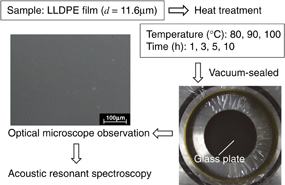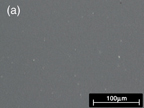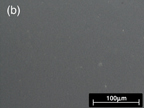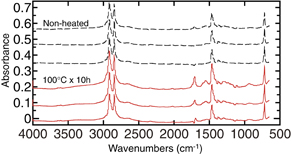Abstract
This paper describes the use of acoustic resonant spectroscopy to monitor the thermal oxidation of a thin polymer film. The samples were linear low-density polyethylene films with thicknesses of 11.6 µm. These were heat treated at temperatures ranging from 80 to 100 °C in a furnace with an air ambient for a maximum of 10 h. Although no obvious difference between the optical microscope images of the films with and without heating were found, the sound velocity and density, which were measured using acoustic resonant spectroscopy, clearly changed depending on the heat treatment temperature and time. These changes in the acoustic properties were confirmed to be due to thermal oxidation of the films and to correlate with the growth of the oxide which depends on the temperature and time of the heat treatment.
Export citation and abstract BibTeX RIS
1. Introduction
Because of their excellent physical properties, i.e., their mechanical strength,1,2) electrical properties,3,4) and chemical resistance,5) etc., plus their geometrical qualities, functional thin polymer films have been widely used in many applications. It is well known that thin polymer films suffer environmental degradation in practical situations, and thus, monitoring this degradation is very much needed in order to ensure their reliability. For example, polymer films degrade at high temperatures due to thermal oxidation.6,7) Generally, oxidation is detrimental for polymers and the growth of the oxide influences their physical properties.
Up till now, the non-destructive characterization of polymers has often been done using ultrasonic techniques to measure the acoustic properties of the polymers, since the acoustic impedance,8) the sound velocity,9–12) the acoustic attenuation,13–16) etc. are known to be related to the crystalline structure or physical properties of the polymer. Although bulk polymers can be characterized by conventional ultrasonic techniques, thinner polymer films are normally difficult to characterize due to the problem of superposition of the signals. Such thin polymer films have been characterized using acoustic resonance phenomenon.17,18) Especially, acoustic resonant spectroscopy, which can be carried out by making observations of the acoustic resonance phenomenon in a system comprising water, the film and a back plate, can precisely measure the acoustic properties of the film.18) The technique can also be used to detect small defects in the film.19) Moreover, if we use a transparent glass plate for the back plate, it is possible to acquire optical microscope images of the film together with its acoustic properties.20) Acoustic resonance phenomenon has also been used to characterize other thin layered media such as oil films,21,22) coatings,23,24) and so on.
In this study, we attempted to monitor the thermal oxidation of linear low-density polyethylene (LLDPE) films using acoustic resonant spectroscopy. The thickness of the LLDPE films was 11.6 µm and these were heat treated at temperatures ranging from 80 to 100 °C in a furnace with an air ambient for a maximum of 10 h, and then acoustically and optically examined. Together with measurements of the acoustic impedance, the sound velocity and the density, optical microscope observations of the films were also performed. The possibility of monitoring thermal oxidation of LLDPE films is discussed based on the acquired data and the results of Fourier transform infrared spectroscopy (FT-IR) analysis.
2. Principal of acoustic resonant spectroscopy
Here we briefly summarize the principal of acoustic resonant spectroscopy for measuring the acoustic properties of thin films. The echo transmittance of a system consisting of water, a thin film and a back plate is denoted by T1, and that of a system consisting of just water and a back plate is denoted by T2. The ratio of the echo transmittances θ (= T1/T2) takes its maximum value θR at the resonant frequency fR. The values of θR and fR are given by18)


where ZT (= ρT cT), ZW and ZB are the acoustic impedances of the film, the water and the back plate, respectively. ρT, cT, d are the density, sound velocity and the thickness of the film. From Eq. (1), we find18)

where  . If ZW and ZB are known, ZT can be determined by measuring θR. Moreover, if one of the three parameters, d, ρT, and cT is known, the remaining two can be found from the measured fR and the determined ZT.
. If ZW and ZB are known, ZT can be determined by measuring θR. Moreover, if one of the three parameters, d, ρT, and cT is known, the remaining two can be found from the measured fR and the determined ZT.
Figure 1 shows the values of θR as functions of ZT and ZB calculated from Eq. (1). Generally, to observe acoustic resonance phenomenon in this system, it is better to use a back plate with high acoustic impedance, and for this reason, a tungsten plate with ZB of 99.8 MN m−3 s is used. Although the acoustic resonance phenomenon is weakened if a glass plate (ZB = 13.5 MN m−3 s) is used instead of the tungsten plate, the acoustic resonance phenomenon can be observed in this three layer system because the value of ZT for typical polymers is in the range from 1.5 to 4 MN m−3 s, see Fig. 1.
Fig. 1. The decibel representation of θR as a function of ZT and ZB.
Download figure:
Standard image High-resolution image3. Experimental procedure
The samples were LLDPE films whose thickness, d, was measured by cross sectional observations with an optical microscope and found to be 11.6 ± 0.3 µm. It is known that the melting point of LLDPE is around 110 °C. Thin polymer films were heat treated at 80, 90, and 100 °C for 1, 3, 5, and 10 h in an air ambient in a furnace with dimensions of 120 × 220 × 100 mm3. The LLDPE films were placed in the furnace after the temperature had reached a constant value. After the heat treatment, the films were cooled to room temperature in air. In this study, we used a glass plate for the back plate in order to carry out acoustical-optical hybrid microscopy.20) The heated films were vacuum sealed onto 1-mm-thick glass plate (Fig. 2), and then inspected using an optical microscope.
Fig. 2. Flow chart for the experiments.
Download figure:
Standard image High-resolution imageAfter the optical microscope observations, the films on the glass plate were examined using acoustic resonant spectroscopy. The ultrasound emitted by the ultrasonic transducer [Olympus NDT V2012 (BC)] had a nominal frequency of 100 MHz and the diameter of the piezoelectric element was 3.2 mm. The echo reflected from the back of the plate was recorded by the same ultrasonic transducer. The distance between the ultrasonic transducer and the glass plate was kept at 5 mm.
The amplitude spectra of the echo from the back-wall of the plate is denoted by φ1, and from that without the film by φ2. The amplitude ratio is given by

Assuming that the signal loss due to ultrasonic attenuation in the film and that at the film/glass plate interface are negligible, γ is equivalent to θ. The validity of these assumptions for typical polymer films without any defects has been confirmed.19) Therefore in this study, we measured γR and fR, and obtained ρT, cT, and ZT.
4. Results and discussion
Examples of optical microscope images of LLDPE films vacuum sealed onto glass plates are shown in Fig. 3. The image of a film without heating is shown in Fig. 3(a) and that of the film heat treated at 100 °C for 10 h is shown in Fig. 3(b). Comparison of these two images confirms that there is no visible change in the appearance of the film due to heating.
Download figure:
Standard image High-resolution imageFig. 3. Optical microscope images of LLDPE films. (a) Non-heated. (b) Heat treated at 100 °C for 10 h.
Download figure:
Standard image High-resolution imageFigure 4 shows examples of the waveforms received by the ultrasonic transducer in the cases with and without films. The films were heat treated at 80, 90, and 100 °C for 10 h or not heated. In these waveforms, there is scarcely any difference.
Fig. 4. Examples of waveforms in the cases with and without films. The waveforms for both heated and non-heated films are shown.
Download figure:
Standard image High-resolution imageFigure 5 shows the amplitude spectra of the received waveforms (top) in cases with and without films and their amplitude ratios (bottom). The result for the film heat treated at 80 °C for 10 h is shown in Fig. 5(a), and that of the film heat treated at 100 °C for 10 h in Fig. 5(b). The amplitude around the center frequency in the cases with a film between the water and the glass plate are greater than those without the film indicating that acoustic resonance phenomenon had occurred when the thin film was in place.
Fig. 5. Amplitude spectra of the back-wall echoes for the cases with and without films (top) and the amplitude ratios (bottom). The films were heat treated at (a) 80 °C and (b) 100 °C for 10 h.
Download figure:
Standard image High-resolution imageThe center frequency for the film heat treated at 80 °C is the same as that for the film that had not been heated, but the center frequency for the film heat treated at 100 °C was found to have shifted towards a lower frequency. This can be more clearly seen in the plots of the amplitude ratio. In the bottom figures, fR is indicated by the arrows. Although γR and fR have not changed as a result of the heat treatment at 80 °C, they have clearly changed as a result of being heated to 100 °C. It was confirmed that d of the film heat treated at 100 °C for 10 h was measured to be 11.5 ± 0.2 µm by the microscope observation and d was unchanged by the heating. These experimental results indicate that the acoustic properties of the film have changed as a result of the temperature of the film being raised to around the melting point of the film.
The acoustic properties determined using acoustic resonant spectroscopy are shown in Fig. 6 as functions of the heat treatment time. The values of ZT, cT, and ρT are shown in the top, middle and bottom figures, respectively. The data for films heat treated at 80, 90, and 100 °C are shown in Figs. 6(a), 6(b), and 6(c), respectively. Here the ranges of all the vertical axes are set to 25% of their value without heating. In the case of films heat treated at 80 °C, the values of ZT, cT, and ρT are unchanged despite the films being held at elevated temperatures for long times. With increasing heat treatment time at 90 °C, ZT remains almost constant, while ρT gradually increases and cT gradually decreases. This tendency is more pronounced for the films heated to 100 °C. The values of cT and ρT gradually change with time, and both seem to saturate after around 5 h.
Fig. 6. The acoustic properties of the LLDPE films as functions of the heating time: top, ZT; middle, cT; bottom, ρT. The films were heat treated at (a) 80, (b) 90, and (c) 100 °C.
Download figure:
Standard image High-resolution imageSimilar changes in the acoustic properties were also observed in the previous study where the same LLDPE film was attached to a hot plate heated at 115 °C for 3 min.20) In the previous study, visible changes in the optical microscope images due to heating were also observed and the formation of many cells with sizes from 10 to 100 µm square suggested that the crystalline structure of the film changed to spherulites. However, no visible change in the appearance of the film due to heating was observed in the present study.
Figure 7 shows the results of FT-IR analysis and the FT-IR spectra were obtained by the attenuated total reflection (ATR) method. Three FT-IR spectra were obtained for three LLDPE films without heating and remained three were for three films heat treated at 100 °C for 10 h. Generally C=O elements appear at around 1710 cm−1 provided that the polyolefin is oxidized. Although the magnitude of the peaks at around 1710 cm−1 is fluctuating, these are surely observed in the spectra for the heat treated films. On the other hand, the peaks at around 1710 cm−1 are not obvious for the films without heating. From the experimental fact, we concluded that the LLDPE film heat treated at 100 °C for 10 h was oxidized. The changes in the acoustic properties were confirmed to be due to thermal oxidation of the film and those against the heating time might correlate with the growth of the oxide. It is noted that the present acoustic resonant spectroscopy has the potential for sensitively monitoring the progress of the oxidation of a polymer film.
Fig. 7. FT-IR spectra for LLDPE film without and with heat treatment at 100 °C for 10 h.
Download figure:
Standard image High-resolution image5. Conclusions
In this paper, we attempted to monitor the thermal oxidation of 11.6 µm thick linear low-density polyethylene films using acoustic resonant spectroscopy. The films were heat treated in the range from 80 to 100 °C in a furnace with air as the ambient gas for a maximum of 10 h. Although no visible changes were observed in optical microscope images of all the examined films, clear changes in the sound velocity and the density were found in the heat treated films. The changes in the acoustic properties of the films were found to depend on the temperature and heat treatment time. It was confirmed by the fourier transform infrared spectroscopy analysis that the changes in the acoustic properties were due to thermal oxidation of the film and that the acoustic resonant spectroscopy described here can be used to monitor the thermal oxidation of thin polymer films.
Acknowledgements
The authors would like to acknowledge Professor M. Saka for his valuable discussions and Mr. S. Kayamori for his great help in FT-IR analysis. This work was supported by JSPS KAKENHI Grant Number 24656076.









